
The Wilcox, Crittenden Mill, also known as Wilcox, Crittenden Mill Historic District, is a 17-acre (6.9 ha) property in Middletown, Connecticut that was listed on the National Register of Historic Places in 1986. It was the location of the Wilcox, Crittenden company, a marine hardware firm. The historic district listing included four contributing buildings and three other contributing sites.

The North Canal Historic District of Lawrence, Massachusetts, encompasses the historic industrial heart of the city. It is centered on the North Canal and the Great Stone Dam, which provided the waterpower for its many mill complexes. The canal was listed on the National Register of Historic Places in 1975, while the district was first listed in 1984, and then expanded slightly in 2009.

Hallville Mill Historic District is a historic district in the town of Preston, Connecticut, that was listed on the National Register of Historic Places in 1996. Contributing properties in the district are 23 buildings, two other contributing structures, and one other contributing site over a 50-acre (20 ha) area. The district includes the dam that forms Hallville Pond, historic manufacturing buildings and worker housing, and the Hallville Mill Bridge, a lenticular pony truss bridge built circa 1890 by the Berlin Iron Bridge Company.
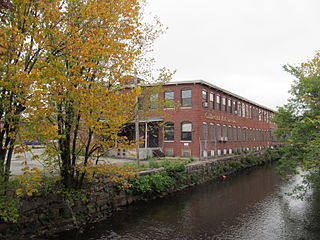
The Earnscliffe Woolen-Paragon Worsted Company Mill Complex is a historic mill at 25 and 39 Manton Avenue in Providence, Rhode Island. It consists of a grouping of eleven industrial buildings on 4.4 acres (1.8 ha) in the Olneyville neighborhood of Providence, on the banks of the Woonasquatucket River. The buildings were built between 1898 and about 1939. Building 1, the oldest building, began in 1898 as a two-story rectangular brick structure with a three-story tower and a monitor roof, but was expanded over the years, obscuring both the tower and the monitor. The complex was begun by the Earnscliff Woolen Company, which failed in 1909. The Paragon Worsted Company purchased the property, and operated on the premises until 1960, when the company closed the mill.

The Warrenton Woolen Mill is a historic textile mill at 839 Main Street in Torrington, Connecticut. Founded in 1844, the mill was a major part of the local economy until its closure in 1984. Its surviving complex, dating to the early 20th century, was listed on the National Register of Historic Places in 1987. It has since been renovated into housing, as the Warrenton Mill Condominiums.

The New Mill and Depot Building of the former Hawthorne Woolen Mill are located in Greenwich, Connecticut, United States. The two structures were built on an existing textile mill complex in the 1870s.
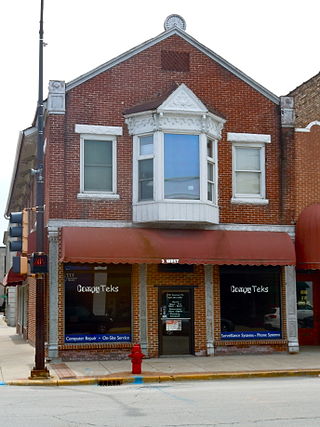
The Stolp Woolen Mill Store was built in 1860. It is located on Stolp Island in Aurora, Illinois. It was listed on the National Register of Historic Places in 1983. It is also a contributing building in the Stolp Island Historic District.
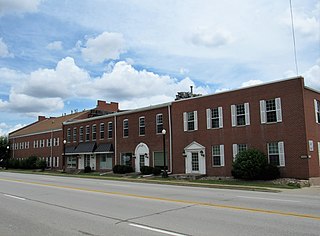
Shields Woolen Mill is located along the edge of the Mississippi River in Davenport, Iowa, United States. It has been listed on the National Register of Historic Places since 1983. The building has been repurposed as commercial and office space called One River Place.

Grand Forks Woolen Mills is a building located on the corner of Third Avenue North and North Third Street in Grand Forks, North Dakota, designed by architect John W. Ross. A three-story construction approximately 50 feet (15 m) by 100 feet (30 m) in size, it is recorded as being built in 1895. Constructed of brick, the architectural style has been described as Commercial vernacular.

The Rich-McCormick Woolen Factory is an historic, American woolen mill that is located in Dunnstable Township in Clinton County, Pennsylvania.

The Winooski Falls Mill District is located along the Winooski River in the cities of Winooski and Burlington, Vermont, in the United States of America. It encompasses a major industrial area that developed around two sets of falls on the river in the 19th century.

The Wood Worsted Mill is located at South Union St. and Merrimack Street, on the south bank of the Merrimack River, in Lawrence, Massachusetts. The mill building was constructed between 1906 and 1909 for the American Woolen Company, and was dubbed by some locals as the "eighth wonder of the world" due to its size. It is a six-story brick building that is 1,300 feet (400 m) long and 125 feet (38 m) high, and encompasses some 17 miles (27 km) of aisles. Its purpose when built was to perform the complete textile manufacturing cycle of worsted woolens, from raw material to finished fabric, under a single roof.

Breck's Mill Area, also known as Breck's Mill Area-Henry Clay Village Historic District, is a national historic district located along Brandywine Creek in unincorporated New Castle County, Delaware, near Wilmington. It encompasses 56 contributing buildings, five contributing sites, and three contributing structures. The district encompasses The Mill, The Workers' houses, and The Mill Owner's Home.

The American Woolen Company Townhouses are a collection of brick townhouses built c. 1907 by the American Woolen Company in Lawrence, Massachusetts. They were part of a program of company-built housing between 1906 and 1910 that included the nearby American Woolen Mill Housing District. The townhouses are located on a series of short streets off Market Street in South Lawrence. A historic district comprising these six buildings was listed on the National Register of Historic Places in 2012.
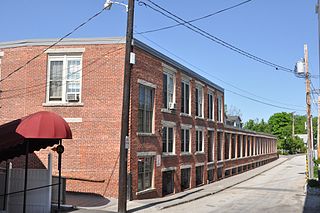
The Milford Cotton and Woolen Manufacturing Company is a historic mill complex at 2 Bridge Street in the center of Milford, New Hampshire. Developed between 1813 and World War I, it is one of the few surviving mill complexes in Milford, whose name is derived in part from "mill". The buildings were listed on the National Register of Historic Places in 1982. The complex has been converted into residential use.

The Holden–Leonard Mill Complex, also known colloquially as the Big Mill and now as Vermont Mill Properties, is a historic industrial complex at 160 Benmont Avenue in Bennington, Vermont. Built of many parts between about 1865 and 1925, it is one of the largest and most architecturally distinctive 19th-century mill complexes in the state, and was a major regional employer for many years. Now redeveloped into a variety of commercial and industrial uses, it was listed on the National Register of Historic Places in 1988.

Meek's Flour Mill is a historic building located in Bonaparte, Iowa, United States. William Meek and Dr. R.N. Cresap laid out the town of Meek's Mill in 1837. Although the town was renamed Bonaparte in 1841, the Meek family had a central role in its development through the turn of the 20th-century. The present building is a three-story, gable roofed, rectangular structure that was built on a raised basement of ashlar limestone blocks. It was constructed in 1878 by William's son Robert, who had succeeded his father in running the family businesses. He was assisted by his brothers Isaiah and Joseph. It replaced the original 1844 mill, which had been destroyed in a fire. While built on the same site, it is unknown if any part of the present structure was a part of the original mill. Two other structures belonging to the Meek's family are located nearby: a woolen mill (1853), and a saw mill (1860).

The Bonaparte Historic Riverfront District is a nationally recognized historic district located in Bonaparte, Iowa, United States. It was listed on the National Register of Historic Places in 1989. At the time of its nomination it contained 38 resources, which included 24 contributing buildings, one contributing structure, 11 non-contributing buildings, and two non-contributing structures. Three mill-related buildings near the Des Moines River are associated with the Meek's family who had a central role in the town's development from its founding through the turn of the 20th-century. They include the woolen mill (1863), the flour mill (1878), which is individually listed on the National Register, and the pants factory (1892). Eighteen commercial buildings are of brick construction. Of those, eight are two-story structures, and ten are single-story structures. The remaining three buildings are wood frame commercial buildings. The single historic structure is the stone lock in the city park, which is also individually listed on the National Register.

The Richards, Dexter, & Sons Woolen Mill, also known locally as the Dexter Mill, is a historic industrial property at 169 Sunapee Street in Newport, New Hampshire. Built in 1905, it is a well-preserved example of period mill architecture, which served as an important area employer for many years. The property was listed on the National Register of Historic Places in 1985.
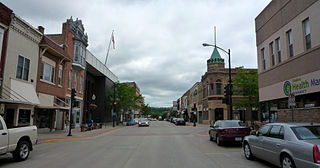
The Decorah Commercial Historic District is a nationally recognized historic district located in Decorah, Iowa, United States. It was listed on the National Register of Historic Places in 2017. At the time of its nomination it contained 126 resources, which included 85 contributing buildings, one contributing structure, and 40 non-contributing buildings. The historic district covers most of the city's central business district. Water Street, which is a major thoroughfare through the district was named after a millrace (non-extant) that rerouted water from the Upper Iowa River to serve the needs of the mills and the commercial district. The land here is relatively flat and allowed for a linear shopping area. The Broadway–Phelps Park Historic District is largely a residential area that is located to the south.
























